Newest Methods and Approaches to Enhance the Performance of Optical Frequency-Domain Reflectometers
Abstract
:1. Introduction
2. Theory
3. Basic Expressions Defining OFDR Parameters
3.1. Maximum Measurement Range
3.2. Spatial Sampling
4. Metrological OFDR Modifications
5. OFDR Sensing Modifications
5.1. Basic Principles of Sensing Using OFDR
5.2. OFDR Parameters Enhancing with Sensing Fibers
5.3. OFDR Software Improvements
5.4. OFDR Hardware Modification to Improve Sensing Performance
5.5. Comprehensive Measures to Improve OFDR Sensing Performance
6. Discrimination of the Temperature and Strain
7. Convergence of OFDR and OTDR Technologies
7.1. TGD-OFDR Technique
7.2. Scanning Coherent OTDR (COTDR) Technique
8. System Simplification and Cost Reduction
- Long coherence length;
- High degree of optical frequency sweeping linearity;
- Wide spectral range.
9. Discussion and Conclusions
- 1.
- This group of works includes studies aimed at imparting special properties to the sensitive element. Thus, fibers with a changed aperture and mode field diameter or with a different composition of doping components, low-mode fibers, and multi-core fibers are used. As already noted, this is a rather expensive solution, and it is not applicable if an SMF-based fiber line is already installed for the object under study. In addition, the new opportunities offered by specialty fibers usually lead to undesirable consequences, such as reduced interrogation length. Moreover, the use of sensors, for example, to estimate the shape of an object using multi-core fibers, entails modification of the software, since processing data from multiple cores is actually a new engineering or even scientific problem;
- 2.
- The second group of works includes software modifications. Signal processing techniques have a significant impact on the accuracy of an OFDR. The most important of them are the laser frequency tuning nonlinearity compensation and temperature and strain extraction algorithms. Often, such studies are carried out on standard, commercial OFDRs, or using the author’s own laboratory equipment, which are structurally no different from well-known setups;
- 3.
- The optical setup is subject to modification. Here we can highlight two main tasks that OFDR hardware modifications are aimed at:
- 3.1.
- Improving the performance of the instrument. This may include polarization channel separation, additional backscattered power amplification, I/Q detection, etc. The integration of OTDR and OFDR methods into each other to obtain improved performance and eliminate the shortcomings of both methods is also included in this category;
- 3.2.
- Simplification of the instrument setup, which leads to a reduction in the market price of a commercial OFDR while maintaining the operational parameters required for various tasks. Since the most expensive element is a highly coherent TLS, more and more research is emerging on replacing this device with an element operating on new physical principles, for example, on the principle of frequency self-scanning;
- 4.
- A group of works in which the modifications mentioned in two or more groups above are made.
Author Contributions
Funding
Data Availability Statement
Conflicts of Interest
Abbreviations
| ACF | Autocorrelation function |
| ADC | Analog-to-digital converter |
| AOM | Acousto-optic modulator |
| AUX | Auxiliary interferometer |
| BEOF | Backscatter enhanced optical fibers |
| BOTDA | Brillouin optical time-domain analyzer |
| BOTDR | Brillouin optical time-domain reflectometer |
| CCF | Cross-correlation function |
| COFDR | Coherent optical frequency-domain reflectomer |
| COTDR | Coherent optical time-domain reflectometer |
| DFB | Distributed feedback |
| DSB | Dual sideband |
| EDFA | Erbium-doped fiber amplifier |
| EFR | Equal frequency resampling |
| EOM | Electro-optical modulator |
| FBG | Fiber Bragg grating |
| FFT | Fast Fourier transform |
| FSL | Frequency shift loop |
| FUT | Fiber under test |
| FWHM | Full width at half maximum |
| MCVD | Modified chemical vapor deposition |
| OFDR | Optical frequency-domain reflectometer |
| OTDR | Optical time-domain reflectometer |
| PCC | Phase cross-correlation |
| PCCF | Phase cross-correlation function |
| PMF | Polarization maintaining fiber |
| PPNE | Periodic-phase-noise-estimated |
| RBS | Rayleigh backscattering spectra |
| RMS | Root mean square |
| SNR | Signal-to-noise ratio |
| SSB | Single sideband |
| SMF | Single-mode fiber |
| TGD-OFDR | Time-gated digital optical frequency-domain reflectometer |
| TLS | Tunable laser source |
| VNA | Vector network analyzer |
| WDM | Wavelength division multiplexer |
| φ-OTDR | Phase-sensitive optical time-domain reflectometer |
References
- Eickhoff, W.F.; Ulrich, R.J.A.P.L. Optical frequency domain reflectometry in single-mode fiber. Appl. Phys. Lett. 1981, 39, 693–695. [Google Scholar] [CrossRef]
- Stepanov, K.V.; Zhirnov, A.A.; Gritsenko, T.V.; Khan, R.I.; Koshelev, K.I.; Svelto, C.; Pnev, A.B. Instability Compensation of Recording Interferometer in Phase-Sensitive OTDR. Sensors 2024, 24, 3338. [Google Scholar] [CrossRef] [PubMed]
- Bengalskii, D.M.; Kharasov, D.R.; Fomiryakov, E.A.; Nikitin, S.P.; Nanii, O.E.; Treshchikov, V.N. Characterization of Laser Frequency Stability by Using Phase-Sensitive Optical Time-Domain Reflectometry. Photonics 2023, 10, 1234. [Google Scholar] [CrossRef]
- Sun, J.; Wang, Y.; Zhang, J.; Liang, Y.; Zhang, G.; Wan, A.; Zhang, S.; Ye, Z.; Zhou, Y.; Jing, Q.; et al. 2-D Phase Unwrapping in DAS Based on Transport-of-Intensity-Equation: Principle, Algorithm and Field Test. J. Light. Technol. 2024. [Google Scholar] [CrossRef]
- Kocal, E.B.; Wuilpart, M.; Yüksel, K. Analysis of crosstalk effects in phase-OTDR system using fiber Bragg grating array. Opt. Fiber Technol. 2023, 75, 103176. [Google Scholar] [CrossRef]
- Li, D.; Yi, D.; Fu, W.; Zhou, X.; Huang, Z.; Geng, Y.; Li, X. Temperature and acoustic field reconstruction in fiber optic DAS system based on variational mode decomposition. IEEE Sens. J. 2024, 24, 16196–16203. [Google Scholar] [CrossRef]
- Taranov, M.A.; Gorshkov, B.G.; Alekseev, A.E.; Potapov, V.T. Distributed strain and temperature sensing over 100 km using tunable-wavelength OTDR based on MEMS filters. Appl. Opt. 2021, 60, 3049–3054. [Google Scholar] [CrossRef]
- Chen, X.; Yu, H. Fast Feature Extraction Method for Brillouin Scattering Spectrum of OPGW Optical Cable Based on BOTDR. Sensors 2023, 23, 8166. [Google Scholar] [CrossRef]
- Wang, Q.; Bai, Q.; Liang, C.; Wang, Y.; Liu, Y.; Jin, B. Random coding method for SNR enhancement of BOTDR. Opt. Express 2022, 30, 11604–11618. [Google Scholar] [CrossRef]
- Bogachkov, I.V.; Gorlov, N.I. Experimental investigations into characteristics of Mandelshtam–Brillouin scattering in single-mode optical fiber of various types. Instrum. Exp. Tech. 2023, 66, 775–781. [Google Scholar] [CrossRef]
- Krivosheev, A.I.; Konstantinov, Y.A.; Barkov, F.L.; Pervadchuk, V.P. Comparative analysis of the Brillouin frequency shift determining accuracy in extremely noised spectra by various correlation methods. Instrum. Exp. Tech. 2021, 64, 715–719. [Google Scholar] [CrossRef]
- Nonogaki, H.; Sei, D.; Zan, M.S.D.; Tanaka, Y. Brillouin frequency shift measurement by zero-crossing point search in virtually synthesized spectra of Brillouin gain and loss. Appl. Phys. Express 2024, 17, 052003. [Google Scholar] [CrossRef]
- Zhang, D.; Yang, Y.; Xu, J.; Ni, L.; Li, H. Structural crack detection using DPP-BOTDA and crack-induced features of the Brillouin gain spectrum. Sensors 2020, 20, 6947. [Google Scholar] [CrossRef] [PubMed]
- Wu, H.; Guo, N.; Zhong, Z.; Guo, W.; Han, L.; Li, C.; Meng, D.; Yin, G.; Liu, T.; Zhu, T. High-performance distributed dynamic strain sensing by synthesizing φ-OTDR and BOTDR. Opt. Express 2023, 31, 18098–18108. [Google Scholar] [CrossRef]
- Chernutsky, A.O.; Khan, R.I.; Gritsenko, T.V.; Koshelev, K.I.; Zhirnov, A.A.; Pnev, A.B. Active Thermostatting of the Reference Optical Fiber Section Method in a Distributed Fiber-Optical Temperature Sensor. Instrum. Exp. Tech. 2023, 66, 824–831. [Google Scholar] [CrossRef]
- Yatseev, V.A.; Zotov, A.M.; Butov, O.V. Combined frequency and phase domain time-gated reflectometry based on a fiber with reflection points for absolute measurements. Results Phys. 2020, 19, 103485. [Google Scholar] [CrossRef]
- Yatseev, V.A.; Butov, O.V. Phase-frequency time-gated reflectometry for absolute measurements. Opt. Sens. 2021, 11772, 158–165. [Google Scholar]
- Yue, Y.; Zeng, J.; Ding, Z.; Zhang, T.; Guo, H.; Liu, T. Long-range distributed vibration sensing based on internal-modulation OFDR. Nanotechnol. Precis. Eng. 2024, 7, 043002. [Google Scholar] [CrossRef]
- Shi, M.; Leandro, D.; Zhu, M.; Murayama, H. Vibration measurement technique by using OFDR with in-line interferometers. In Proceedings of the 10th European Workshop on Structural Health Monitoring (EWSHM 2024), Potsdam, Germany, 10–13 June 2024. [Google Scholar]
- Perrot, J.; Morana, A.; Marin, E.; Boukenter, A.; Ouerdane, Y.; Bertrand, J.; Boiron, H.; Girard, S. Distributed Optical Fiber-based Dosimetry with Optical Frequency Domain Reflectometry. IEEE Sens. J. 2024, 24, 20688–20695. [Google Scholar] [CrossRef]
- Matveenko, V.; Serovaev, G. Distributed Strain Measurements Based on Rayleigh Scattering in the Presence of Fiber Bragg Gratings in an Optical Fiber. Photonics 2023, 10, 868. [Google Scholar] [CrossRef]
- Fan, B.; Chen, C.; Wu, Q.; Wang, Y.; Liu, Y.; Zhang, H. Temperature and strain monitoring during thermoforming of thermoplastic composite laminates using optical frequency domain reflectometry. Smart Mater. Struct. 2024, 33, 035021. [Google Scholar] [CrossRef]
- Hamdi, I.; Magne, S.; Rougeautlt, S.; Mongabure, P.; Vasic, S.; Charbonnel, P.E.; Wang, F.; Hervé-Secourgeon, E.; Voldoire, F. Damage Assessment in a Reinforced Concrete Structure under Quasi-Static Shear Loading Using OFDR-based Fibre-Optic Distributed Strain Monitoring. Struct. Health Monit. 2023. [Google Scholar] [CrossRef]
- Wada, D.; Igawa, H.; Tamayama, M.; Kasai, T.; Arizono, H.; Murayama, H.; Shiotsubo, K. Flight demonstration of using optical fiber distributed sensing system. Smart Mater. Struct. 2018, 27, 025014. [Google Scholar] [CrossRef]
- Bai, Q.; Yang, G.; Liang, C.; Zhou, X.; Xue, H.; Wang, Y.; Liu, X.; Jin, B. Accuracy improvement of two-dimensional shape reconstruction based on OFDR using first-order differential local filtering. Opt. Express 2024, 32, 19006–19018. [Google Scholar] [CrossRef]
- Krivosheina, D.A.; Tkachenko, A.Y.; Lobach, I.A.; Kablukov, S.I. Sensivity Optimization for a Coherent Optical Frequency-Domain Reflectometer Based on a Self-Sweeping Fiber Laser. In Proceedings of the 2022 IEEE 23rd International Conference of Young Professionals in Electron Devices and Materials (EDM), Altai, Russia, 30 June 2022–4 July 2022; pp. 352–355. [Google Scholar]
- Zou, C.; Lin, C.; Mou, T.; Yu, Z.; Zhu, Y.; Zhu, Y.; Dang, F.; Yuan, Y.; Yang, J.; Wang, Y.; et al. Beyond a 107 range-resolution− 1 product in an OFDR based on a periodic phase noise estimation method. Opt. Lett. 2022, 47, 5373–5376. [Google Scholar] [CrossRef]
- Guo, Z.; Han, G.; Yan, J.; Greenwood, D.; Marco, J.; Yu, Y. Ultimate spatial resolution realisation in optical frequency domain reflectometry with equal frequency resampling. Sensors 2021, 21, 4632. [Google Scholar] [CrossRef]
- Dang, H.; Tian, Y.; Liu, H.; Cheng, L.; Chen, J.; Feng, K.; Cui, J.; Shum, P.P. Dynamic wavelength calibration based on synchrosqueezed wavelet transform. Opt. Express 2022, 30, 46722–46733. [Google Scholar] [CrossRef]
- Zhong, H.; Fu, C.; Li, P.; Du, B.; Du, C.; Meng, Y.; Yin, X.; Liao, C.; Wang, Y. Ultra-linear broadband optical frequency sweep for a long-range and centimeter-spatial-resolution OFDR. Opt. Lett. 2023, 48, 4540–4543. [Google Scholar] [CrossRef]
- Yang, F.; Zhang, L.J.; Zhang, Z.Y.; Zhou, X.J.; Liu, Y. Nonlinearity-compensation-free optical frequency domain reflectometry based on electrically-controlled optical frequency sweep. J. Electron. Sci. Technol. 2021, 19, 100025. [Google Scholar] [CrossRef]
- Zhu, Y.; Fan, X.; Zhang, Z.; Yuan, Z.; Xu, B.; He, Z. Optical frequency domain reflectometry with broadened frequency sweep range assisted by a dual electro-optic frequency comb. Opt. Lett. 2023, 48, 4937–4940. [Google Scholar] [CrossRef]
- Qi, G.; Zhang, S.; Feng, S.; Fu, Y. Improvement of high sensitivity ICR characteristics and its application in OFDR. J. Phys. Conf. Ser. 2024, 2722, 012003. [Google Scholar] [CrossRef]
- Belokrylov, M.E.; Claude, D.; Konstantinov, Y.A.; Karnaushkin, P.V.; Ovchinnikov, K.A.; Krishtop, V.V.; Gilev, D.G.; Barkov, F.L.; Ponomarev, R.S. Method for Increasing the Signal-to-Noise Ratio of Rayleigh Back-Scattered Radiation Registered by a Frequency Domain Optical Reflectometer Using Two-Stage Erbium Amplification. Instrum. Exp. Tech. 2023, 66, 761–768. [Google Scholar] [CrossRef]
- Mou, T.; Zhu, Y.; Lin, C.; Zou, C.; Xie, D.; Zhu, Y.; Dang, F.; Yuan, Y.; Gao, F.; Yang, J. Suppression of wavelength-dependent polarization fading using hybrid-polarization scheme in OFDR. Opt. Express 2024, 32, 1552–1561. [Google Scholar] [CrossRef]
- Feng, Y.; Xie, W.; Meng, Y.; Zhang, L.; Liu, Z.; Wei, W.; Dong, Y. High-performance optical frequency-domain reflectometry based on high-order optical phase-locking-assisted chirp optimization. J. Light. Technol. 2020, 38, 6227–6236. [Google Scholar] [CrossRef]
- Riza, M.A.; Go, Y.I.; Harun, S.W.; Maier, R.R. FBG sensors for environmental and biochemical applications—A review. IEEE Sens. J. 2020, 20, 7614–7627. [Google Scholar] [CrossRef]
- Matveenko, V.P.; Serovaev, G.S.; Kosheleva, N.A.; Galkina, E.B. Investigation of fiber Bragg grating's spectrum response to strain gradient. Procedia Struct. Integr. 2024, 54, 218–224. [Google Scholar] [CrossRef]
- Markvart, A.A.; Liokumovich, L.B.; Medvedev, I.O.; Ushakov, N.A. Smartphone-based interrogation of a chirped FBG strain sensor inscribed in a multimode fiber. J. Light. Technol. 2021, 39, 282–289. [Google Scholar] [CrossRef]
- Agliullin, T.; Anfinogentov, V.; Morozov, O.; Sakhabutdinov, A.; Valeev, B.; Niyazgulyeva, A.; Garovov, Y. Comparative analysis of the methods for fiber Bragg structures spectrum modeling. Algorithms 2023, 16, 101. [Google Scholar] [CrossRef]
- Soller, B.J.; Gifford, D.K.; Wolfe, M.S.; Froggatt, M.E. High-resolution fiber reflectometry for avionics applications. In Proceedings of the IEEE Conference Avionics Fiber-Optics and Photonics, Minneapolis, MN, USA, 20–22 September 2005; pp. 56–57. [Google Scholar]
- Kreger, S.T.; Gifford, D.K.; Froggatt, M.E.; Soller, B.J.; Wolfe, M.S. High resolution distributed strain or temperature measurements in single-and multi-mode fiber using swept-wavelength interferometry. In Proceedings of the Optical Fiber Sensors, Cancun, Mexico, 23–27 October 2006; p. ThE42. [Google Scholar]
- Sollerv, B.J.; Gifford, D.K.; Wolfe, M.S.; Froggatt, M.E.; Yu, M.H.; Wysocki, P.F. Measurement of localized heating in fiber optic components with millimeter spatial resolution. In Proceedings of the Optical Fiber Communication Conference, Anaheim, CA, USA, 5–10 March 2006; p. OFN3. [Google Scholar]
- Ding, Z.; Wang, C.; Liu, K.; Jiang, J.; Yang, D.; Pan, G.; Pu, Z.; Liu, T. Distributed optical fiber sensors based on optical frequency domain reflectometry: A review. Sensors 2018, 18, 1072. [Google Scholar] [CrossRef]
- Li, C.; Zheng, H.; Ma, L.; Zhu, C.; Zhuang, Y.; Peng, W.; Wang, J.; Hu, W.; Rao, Y.J. Optimizing the demodulation method for DAS system based on point-backscattering-enhanced fiber. IEEE Trans. Instrum. Meas. 2024, 73, 1–8. [Google Scholar] [CrossRef]
- Wang, F.; Yu, Y.; Hong, R.; Tian, R.; Zhang, Y.; Zhang, X. The Impact of Rayleigh Scattering in UWFBG Array-Based Φ-OTDR and Its Suppression Method. Sensors 2023, 23, 5063. [Google Scholar] [CrossRef] [PubMed]
- Masoudi, A.; Lee, T.; Beresna, M.; Brambilla, G. 10-cm spatial resolution distributed acoustic sensor based on an ultra low-loss enhanced backscattering fiber. Opt. Contin. 2022, 1, 2002–2010. [Google Scholar] [CrossRef]
- Lv, Y.; Xiao, X.; Li, H.; Ai, K.; Yan, Z.; Sun, Q. Strain measurement with adaptive local feature extraction method based on special fiber OFDR system. Opt. Express 2024, 32, 5043–5055. [Google Scholar] [CrossRef] [PubMed]
- Lu, Z.; Feng, T.; Li, F.; Yao, X.S. Optical Frequency-Domain Reflectometry Based Distributed Temperature Sensing Using Rayleigh Backscattering Enhanced Fiber. Sensors 2023, 23, 5748. [Google Scholar] [CrossRef]
- Bulot, P.; Bernard, R.; Cieslikiewicz-Bouet, M.; Laffont, G.; Douay, M. Performance study of a zirconia-doped fiber for distributed temperature sensing by OFDR at 800 °C. Sensors 2021, 21, 3788. [Google Scholar] [CrossRef]
- Li, J.; Wang, Y.; Xiao, L.; Liu, X.; Jin, B. SNR enhancement with a non-local means image-denoising method for a Φ-OTDR system. Appl. Opt. 2023, 62, 2283–2291. [Google Scholar] [CrossRef]
- Li, J.; Wang, Y.; Wang, P.; Zhong, J.; Bai, Q.; Jin, B. Detection range enhancement for Φ-OTDR using semantic image segmentation. J. Light. Technol. 2022, 40, 4886–4895. [Google Scholar] [CrossRef]
- Turov, A.T.; Barkov, F.L.; Konstantinov, Y.A.; Korobko, D.A.; Lopez-Mercado, C.A.; Fotiadi, A.A. Activation function dynamic averaging as a technique for nonlinear 2D data denoising in distributed acoustic sensors. Algorithms 2023, 16, 440. [Google Scholar] [CrossRef]
- Qian, X.; Wang, Z.; Wang, S.; Xue, N.; Sun, W.; Zhang, L.; Zhang, B.; Rao, Y. 157km BOTDA with pulse coding and image processing. In Proceedings of the Sixth European Workshop on Optical Fibre Sensors, Limerick, Ireland, 31 May–3 June 2016; pp. 395–398. [Google Scholar]
- Soto, M.A.; Ramírez, J.A.; Thévenaz, L. Optimizing image denoising for long-range Brillouin distributed fiber sensing. J. Light. Technol. 2017, 36, 1168–1177. [Google Scholar] [CrossRef]
- Hu, Y.; Shang, Q. Performance enhancement of BOTDA based on the image super-resolution reconstruction. IEEE Sens. J. 2021, 22, 3397–3404. [Google Scholar] [CrossRef]
- Qu, S.; Qin, Z.; Xu, Y.; Cong, Z.; Wang, Z.; Liu, Z. Improvement of strain measurement range via image processing methods in OFDR system. J. Light. Technol. 2021, 39, 6340–6347. [Google Scholar] [CrossRef]
- Sweeney, D.C.; Petrie, C.M. Expanding the range of the resolvable strain from distributed fiber optic sensors using a local adaptive reference approach. Opt. Lett. 2022, 47, 269–272. [Google Scholar] [CrossRef]
- Aitkulov, A.; Marcon, L.; Chiuso, A.; Palmieri, L.; Galtarossa, A. Machine Learning Estimation of the Phase at the Fading Points of an OFDR-Based Distributed Sensor. Sensors 2022, 23, 262. [Google Scholar] [CrossRef]
- Cui, J.; Zhao, S.; Yang, D.; Ding, Z. Investigation of the interpolation method to improve the distributed strain measurement accuracy in optical frequency domain reflectometry systems. Appl. Opt. 2018, 57, 1424–1431. [Google Scholar] [CrossRef]
- Wang, C.; Liu, K.; Ding, Z.; Jiang, J.; Chen, Z.; Feng, Y.; Zheng, Y.; Liu, Q.; Liu, T. High sensitivity distributed static strain sensing based on differential relative phase in optical frequency domain reflectometry. J. Light. Technol. 2020, 38, 5825–5836. [Google Scholar] [CrossRef]
- Zhao, S.; Cui, J.; Wu, Z.; Wang, Z.; Tan, J. Distributed fiber deformation measurement by high-accuracy phase detection in OFDR scheme. J. Light. Technol. 2021, 39, 4101–4108. [Google Scholar] [CrossRef]
- Tanimura, D.; Ogu, R.; Zhang, C.; Ito, F.; Yoshimura, Y.; Aoshika, H.; Imai, M. Over 1 km Large Strain Measurement with 70+ Times Range Expansion by using Phase-Noise Compensated OFDR. In Proceedings of the Optical Fiber Sensors, Hamamatsu-shi, Japan, 20–24 November 2023; pp. F2–F5. [Google Scholar]
- Zhu, T.; Lin, C.; Yang, J.; Yu, Z.; Xu, P.; Wen, K.; Wang, Y.; Qin, Y. Improve accuracy and measurement range of sensing in km-level OFDR using spectral splicing method. Opt. Express 2023, 31, 20980–20993. [Google Scholar] [CrossRef] [PubMed]
- Lin, Y.; Yang, J.; Zhang, X.; Lin, C.; Wang, Y.; Qin, Y. High accuracy distributed strain testing of km-level length fiber coil of gyroscopy using OFDR. In Proceedings of the Optical Fiber Sensors, Hamamatsu-shi, Japan, 20–24 November 2023; pp. W4–W37. [Google Scholar]
- Zhang, Z.; Peng, W.; Alsalman, O.; Ma, L.; Huang, J.; Zhu, C. Optical frequency domain reflectometry-based high-performance distributed sensing empowered by a data and physics-driven neural network. Opt. Express 2024, 32, 25074–25090. [Google Scholar] [CrossRef]
- Jderu, A.; Soto, M.A.; Enachescu, M.; Ziegler, D. Realization of a polarization-insensitive optical frequency-domain reflectometer using an I/Q homodyne detection. J. Eur. Opt. Soc.-Rapid Publ. 2021, 17, 22. [Google Scholar] [CrossRef]
- Zhang, Z.; Fan, X.; He, Z. Long-range distributed static strain sensing with <100 nano-strain resolution realized using OFDR. J. Light. Technol. 2019, 37, 4590–4596. [Google Scholar]
- Zhou, D.P.; Chen, L.; Bao, X. Distributed dynamic strain measurement using optical frequency-domain reflectometry. Appl. Opt. 2016, 55, 6735–6739. [Google Scholar] [CrossRef]
- Fan, X.; Koshikiya, Y.; Ito, F. Phase-noise-compensated optical frequency domain reflectometry with measurement range beyond laser coherence length realized using concatenative reference method. Opt. Lett. 2007, 32, 3227–3229. [Google Scholar] [CrossRef] [PubMed]
- Yang, Q.; Xie, W.; Yang, J.; Yan, R.; Wang, C.; Zheng, X.; Dong, Y. Interval-locked dual-frequency φ-OFDR with an enhanced strain dynamic range and a long-term stability. Opt. Lett. 2023, 48, 5523–5526. [Google Scholar] [CrossRef]
- Qin, J.; Zhang, L.; Xie, W.; Cheng, R.; Liu, Z.; Wei, W.; Dong, Y. Ultra-long range optical frequency domain reflectometry using a coherence-enhanced highly linear frequency-swept fiber laser source. Opt. Express 2019, 27, 19359–19368. [Google Scholar] [CrossRef]
- Yin, G.; Zhu, Z.; Liu, M.; Wang, Y.; Liu, K.; Yu, K.; Zhu, T. Optical frequency domain reflectometry based on multilayer perceptron. Sensors 2023, 23, 3165. [Google Scholar] [CrossRef] [PubMed]
- Li, X.; Zhu, Y.; Lin, C.; Zou, C.; Zhu, Y.; Dang, F.; Lin, Y.; Yan, Y.; Yang, J. Performance improvement of a distributed temperature sensor with kilometer length and centimeter spatial resolution based on polarization-sensitive OFDR. Sens. Actuators A Phys. 2024, 373, 115430. [Google Scholar] [CrossRef]
- Nonogaki, H.; Hoshino, K.; Saito, D.; Zan, M.S.D.B.; Tanaka, Y. Brillouin frequency shift estimation for Brillouin optical time domain analysis using Brillouin gain and loss spectra with SVC. IEEE Sens. J. 2024, 24, 14261–14269. [Google Scholar] [CrossRef]
- Budylin, G.S.; Gorshkov, B.G.; Gorshkov, G.B.; Zhukov, K.M.; Paramonov, V.M.; Simikin, D.E.E. Brillouin optical reflectometer with a Brillouin active filter. Quantum Electron. 2017, 47, 597. [Google Scholar] [CrossRef]
- Hamzah, A.E.; Zan, M.S.D.; Hamzah, M.E.; Fadhel, M.M.; Sapiee, N.M.; Bakar, A.A.A. Fast and accurate measurement in BOTDA fibre sensor through the application of filtering techniques in frequency and time domains. IEEE Sens. J. 2024, 24, 4531–4541. [Google Scholar] [CrossRef]
- Zahoor, R.; Vallifuoco, R.; Zeni, L.; Minardo, A. Distributed Temperature Sensing through Network Analysis Frequency-Domain Reflectometry. Sensors 2024, 24, 2378. [Google Scholar] [CrossRef]
- Liu, K.; Yin, G.; Zhang, Z.; Zhong, Z.; Lu, H.; Li, D.; Zhu, T. Sub-millimeter resolution and high-precision φ-OFDR using a complex-domain denoising method. Opt. Lett. 2024, 49, 29–32. [Google Scholar] [CrossRef] [PubMed]
- Li, H.; Liu, Q.; Chen, D.; Deng, Y.; He, Z. High-spatial-resolution fiber-optic distributed acoustic sensor based on Φ-OFDR with enhanced crosstalk suppression. Opt. Lett. 2020, 45, 563–566. [Google Scholar] [CrossRef]
- Shiloh, L.; Eyal, A. Fast sinusoidal frequency scan OFDR for long distance distributed acoustic sensing. In Proceedings of the 2017 25th Optical Fiber Sensors Conference (OFS), Jeju, Republic of Korea, 24–28 April 2017; pp. 1–4. [Google Scholar]
- Marcon, L.; Galtarossa, A.; Palmieri, L. High-frequency high-resolution distributed acoustic sensing by optical frequency domain reflectometry. Opt. Express 2019, 27, 13923–13933. [Google Scholar] [CrossRef]
- Froggatt Mark, E. Distributed Strain and Temperature Discrimination in Polarization Maintaining Fiber. U.S. Patent 7538883, 26 May 2009. [Google Scholar]
- Ding, Z.; Yang, D.; Du, Y.; Liu, K.; Zhou, Y.; Zhang, R.; Xu, Z.; Jiang, J.; Liu, T. Distributed strain and temperature discrimination using two types of fiber in OFDR. IEEE Photonics J. 2016, 8, 6804608. [Google Scholar] [CrossRef]
- Naeem, K.; Lee, C.; Linganna, K.; Kang, C.; Oh, M.K.; Yu, N.E.; Kang, H.; Kim, B.H. Multiparameter distributed fiber sensor based on optical frequency-domain reflectometry and bandwidth-division multiplexing. IEEE Sens. J. 2021, 21, 25703–25709. [Google Scholar] [CrossRef]
- Bao, X.; Li, W.; Qin, Z.; Chen, L. OTDR and OFDR for distributed multi-parameter sensing. In Proceedings of the Smart Sensor Phenomena, Technology, Networks, and Systems Integration, San Diego, CA, USA, 8 March 2014; p. 906202. [Google Scholar]
- Qin, Z.; Qu, S.; Wang, Z.; Yang, W.; Li, S.; Liu, Z.; Xu, Y. A fully distributed fiber optic sensor for simultaneous relative humidity and temperature measurement with polyimide-coated polarization maintaining fiber. Sens. Actuators B Chem. 2022, 373, 132699. [Google Scholar] [CrossRef]
- Zhou, D.P.; Li, W.; Chen, L.; Bao, X. Distributed temperature and strain discrimination with stimulated Brillouin scattering and Rayleigh backscatter in an optical fiber. Sensors 2013, 13, 1836–1845. [Google Scholar] [CrossRef] [PubMed]
- Pedraza, A.; Del Río, D.; Bautista-Juzgado, V.; Fernández-López, A.; Sanz-Andrés, Á. Study of the Feasibility of Decoupling Temperature and Strain from a ϕ-PA-OFDR over an SMF Using Neural Networks. Sensors 2023, 23, 5515. [Google Scholar] [CrossRef]
- Liu, Q.; Fan, X.; He, Z. Time-gated digital optical frequency domain reflectometry with 1.6-m spatial resolution over entire 110-km range. Opt. Express 2015, 23, 25988–25995. [Google Scholar] [CrossRef]
- Wang, S.; Fan, X.; Liu, Q.; He, Z. Distributed fiber-optic vibration sensing based on phase extraction from time-gated digital OFDR. Opt. Express 2015, 23, 33301–33309. [Google Scholar] [CrossRef]
- Dai, J.; Qiu, J.; Liu, H.; Luo, Y.; Liu, Q. High Spatial Resolution TGD-OFDR Based on Internally Modulated DFB Laser. Acta Opt. Sin. 2023, 43, 0728001. [Google Scholar]
- Kishida, K.; Guzik, A.; Nishiguchi, K.I.; Li, C.H.; Azuma, D.; Liu, Q.; He, Z. Development of real-time time gated digital (TGD) OFDR method and its performance verification. Sensors 2021, 21, 4865. [Google Scholar] [CrossRef] [PubMed]
- Liehr, S.; Münzenberger, S.; Krebber, K. Wavelength-scanning coherent OTDR for dynamic high strain resolution sensing. Opt. Express 2018, 26, 10573–10588. [Google Scholar] [CrossRef] [PubMed]
- Gorshkov, B.G.; Taranov, M.A.; Alekseev, A.E. Distributed stress and temperature sensing based on Rayleigh scattering of low-coherence light. Laser Phys. 2017, 27, 085105. [Google Scholar] [CrossRef]
- Hu, T.; Zhang, Y.; Yang, S.; Yuan, L. A Frequency-Scanned Φ-OTDR Implemented by a Frequency Shifting Loop Used for Distributed Strain Sensing. J. Light. Technol. 2024, 42, 5428–5434. [Google Scholar] [CrossRef]
- Taranov, M.A.; Gorshkov, B.G.; Alekseev, A.E. Achievement of an 85 km distance range of strain (temperature) measurements using low-coherence Rayleigh reflectometry. Instrum. Exp. Tech. 2020, 63, 527–531. [Google Scholar] [CrossRef]
- Muñoz, F.; Romero, L.; Soto, M.A. Reducing large errors in frequency-scanned phase-sensitive optical time-domain reflectometers using phase cross correlation. Opt. Lett. 2022, 47, 5521–5524. [Google Scholar] [CrossRef] [PubMed]
- Zhang, L.; Yang, Z.; Gorbatov, N.; Davidi, R.; Galal, M.; Thévenaz, L.; Tur, M. Distributed and dynamic strain sensing with high spatial resolution and large measurable strain range. Opt. Lett. 2020, 45, 5020–5023. [Google Scholar] [CrossRef]
- Wang, Y.; Ding, K.; Wu, H.; Zhao, T.; Wu, Y.; Cui, Q.; Chen, Y.; Lei, Y.; Qin, L. Tunable Narrow Linewidth External Cavity Diode Laser Employing Wide Interference Filter and Diffraction Grating. Appl. Sci. 2023, 13, 10790. [Google Scholar] [CrossRef]
- Babin, S.A.; Kablukov, S.I.; Vlasov, A.A. Tunable fiber Bragg gratings for application in tunable fiber lasers. Laser Phys. 2007, 17, 1323–1326. [Google Scholar] [CrossRef]
- Terentyev, V.S.; Simonov, V.A.; Babin, S.A. Multiple-beam reflection interferometer formed in a single-mode fiber for applications in fiber lasers. Opt. Express 2016, 24, 4512–4518. [Google Scholar] [CrossRef]
- Wang, Q.; Lalam, N.; Zhao, K.; Zhong, S.; Zhang, G.; Wright, R.; Chen, K.P. Simulation Analysis of Mode Hopping Impacts on OFDR Sensing Performance. Photonics 2024, 11, 580. [Google Scholar] [CrossRef]
- Wang, Q.; Zhao, K.; Yi, X.; Zhao, J.; Zhong, S.; Chen, K.P. Low-cost OFDR distributed sensing based on optical fiber with enhanced rayleigh backscattering profiles and Median filtering. In Proceedings of the Optical Fiber Sensors, Alexandria, VA, USA, 29 August–2 September 2022; p. Th4.48. [Google Scholar]
- Zhang, J.; Su, L.; Liu, C.; Chu, Y.; Fu, X.; Jin, W.; Bi, W.; Fu, G. High Spatial Resolution OFDR Based on In-Current Modulation of DFB Laser. Acta Opt. Sin. 2023, 43, 2314001. [Google Scholar]
- Badar, M.; Lu, P.; Buric, M.; Ohodnicki, P., Jr. Integrated auxiliary interferometer for self-correction of nonlinear tuning in optical frequency domain reflectometry. J. Light. Technol. 2020, 38, 6097–6103. [Google Scholar] [CrossRef]
- Yao, Z.; Mauldin, T.; Xu, Z.; Hefferman, G.; Wei, T. Compact multifunction digital OFDR system without using an auxiliary interferometer. Appl. Opt. 2021, 60, 7523–7529. [Google Scholar] [CrossRef]
- Zhong, H.; Fu, C.; Wang, L.; Du, B.; Li, P.; Meng, Y.; Chen, L.; Du, C.; Wang, Y. High-spatial-resolution OFDR with single interferometer using self-compensation method. Opt. Lasers Eng. 2023, 161, 107341. [Google Scholar] [CrossRef]
- Horikx, J.J.L.; Hooft, G.W.T.; Marell, M.J.H. Optical Frequency Domain Reflectometry (OFDR) System. U.S. Patent 9553664, 24 January 2017. [Google Scholar]
- Belokrylov, M.E.; Kambur, D.A.; Konstantinov, Y.A.; Claude, D.; Barkov, F.L. An Optical Frequency Domain Reflectometer’s (OFDR) Performance Improvement via Empirical Mode Decomposition (EMD) and Frequency Filtration for Smart Sensing. Sensors 2024, 24, 1253. [Google Scholar] [CrossRef]
- Rønnekleiv, E. Frequency and intensity noise of single frequency fiber Bragg grating lasers. Opt. Fiber Technol. 2001, 7, 206–235. [Google Scholar] [CrossRef]
- Oberson, P.; Huttner, B.; Guinnard, O.; Guinnard, L.; Ribordy, G.; Gisin, N. Optical frequency domain reflectometry with a narrow linewidth fiber laser. IEEE Photonics Technol. Lett. 2000, 12, 867–869. [Google Scholar] [CrossRef]
- Waagaard, O.H. Fiber laser with high sweep linearity for OFDR measurements. In Proceedings of the Optical Fiber Sensors, Cancun, Mexico, 23–27 October 2006; p. ThE49. [Google Scholar]
- Poddubrovskii, N.R.; Drobyshev, R.V.; Lobach, I.A.; Kablukov, S.I. Fiber lasers based on dynamic population gratings in rare-earth-doped optical fibers. Photonics 2022, 9, 613. [Google Scholar] [CrossRef]
- Tkachenko, A.Y.; Lobach, I.A.; Kablukov, S.I. Coherent optical frequency-domain reflectometer based on a fibre laser with frequency self-scanning. Quantum Electron. 2019, 49, 1121. [Google Scholar] [CrossRef]
- Tkachenko, A.Y.; Smolyaninov, N.N.; Skvortsov, M.I.; Lobach, I.A.; Kablukov, S.I. A coherent optical frequency-domain reflectometer based on a self-sweeping fiber laser for sensing applications. Instrum. Exp. Tech. 2020, 63, 532–537. [Google Scholar] [CrossRef]
- Krivosheina, D.A.; Tkachenko, A.Y.; Lobach, I.A.; Kablukov, S.I. Coherent Optical Frequency Reflectometer Based on a Self-sweeping Fiber Laser for Distributed Measurements. Bull. Lebedev Phys. Inst. 2023, 50 (Suppl. S3), S305–S313. [Google Scholar] [CrossRef]
- Poddubrovskii, N.R.; Lobach, I.A.; Kablukov, S.I. Signal Processing in Optical Frequency Domain Reflectometry Systems Based on Self-Sweeping Fiber Laser with Continuous-Wave Intensity Dynamics. Algorithms 2023, 16, 260. [Google Scholar] [CrossRef]
- Wang, K.; Wen, Z.; Guo, W.; Xiong, Y.; Yang, L.; Wang, P. Amplitude modulation ranging achieved by self-sweeping fiber laser in a short distance. Infrared Phys. Technol. 2023, 134, 104895. [Google Scholar] [CrossRef]
- Wang, K.; Wen, Z.; Wang, P. Intracavity ranging enabled by a single-frequency self-sweeping fiber laser with a few-longitudinal-mode range. Opt. Express 2022, 30, 47115–47123. [Google Scholar] [CrossRef]
- Meng, X.; Luo, M.; Liu, J.; Zhao, S.; Zhou, R. Birefringence characterization in a dual-hole microstructured optical fiber using an OFDR method. Appl. Opt. 2024, 63, 772–776. [Google Scholar] [CrossRef]
- Matveenko, V.P.; Serovaev, G.S.; Kosheleva, N.A.; Gusev, G.N. On application of distributed FOS embedded into material for the mechanical state monitoring of civil structures. Procedia Struct. Integr. 2021, 33, 925–932. [Google Scholar]
- Yüksel, K.; Pala, D. Analytical investigation of a novel interrogation approach of fiber Bragg grating sensors using Optical Frequency Domain Reflectometry. Opt. Lasers Eng. 2016, 81, 119–124. [Google Scholar] [CrossRef]
- Kosheleva, N.; Serovaev, G.; Gusev, G. Application of two types of embedded fiber-optic sensors for process-induced strain measurement in cement mixture. In Proceedings of the IOP Conference Series: Materials Science and Engineering, Barnaul, Russia, 20–21 November 2020; p. 012038. [Google Scholar]
- Venketeswaran, A.; Lalam, N.; Wuenschell, J.; Ohodnicki, P.R., Jr.; Badar, M.; Chen, K.P.; Lu, P.; Duan, Y.; Chorpening, B.; Buric, M. Recent advances in machine learning for fiber optic sensor applications. Adv. Intell. Syst. 2022, 4, 2100067. [Google Scholar] [CrossRef]
- Gemeinhardt, H.; Sharma, J. Machine Learning-Assisted Leak Detection using Distributed Temperature and Acoustic Sensors. IEEE Sens. J. 2023, 24, 1520–1531. [Google Scholar] [CrossRef]

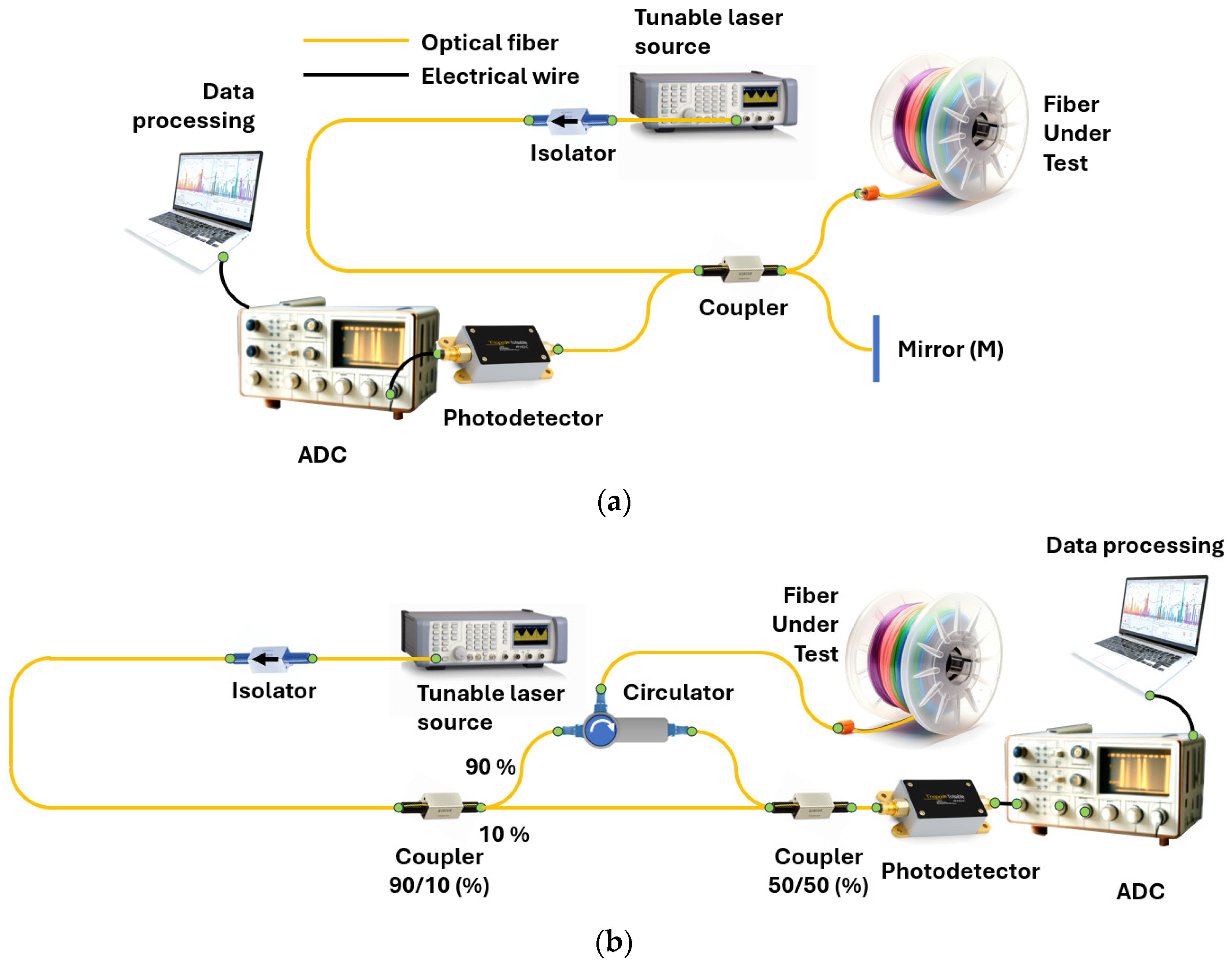

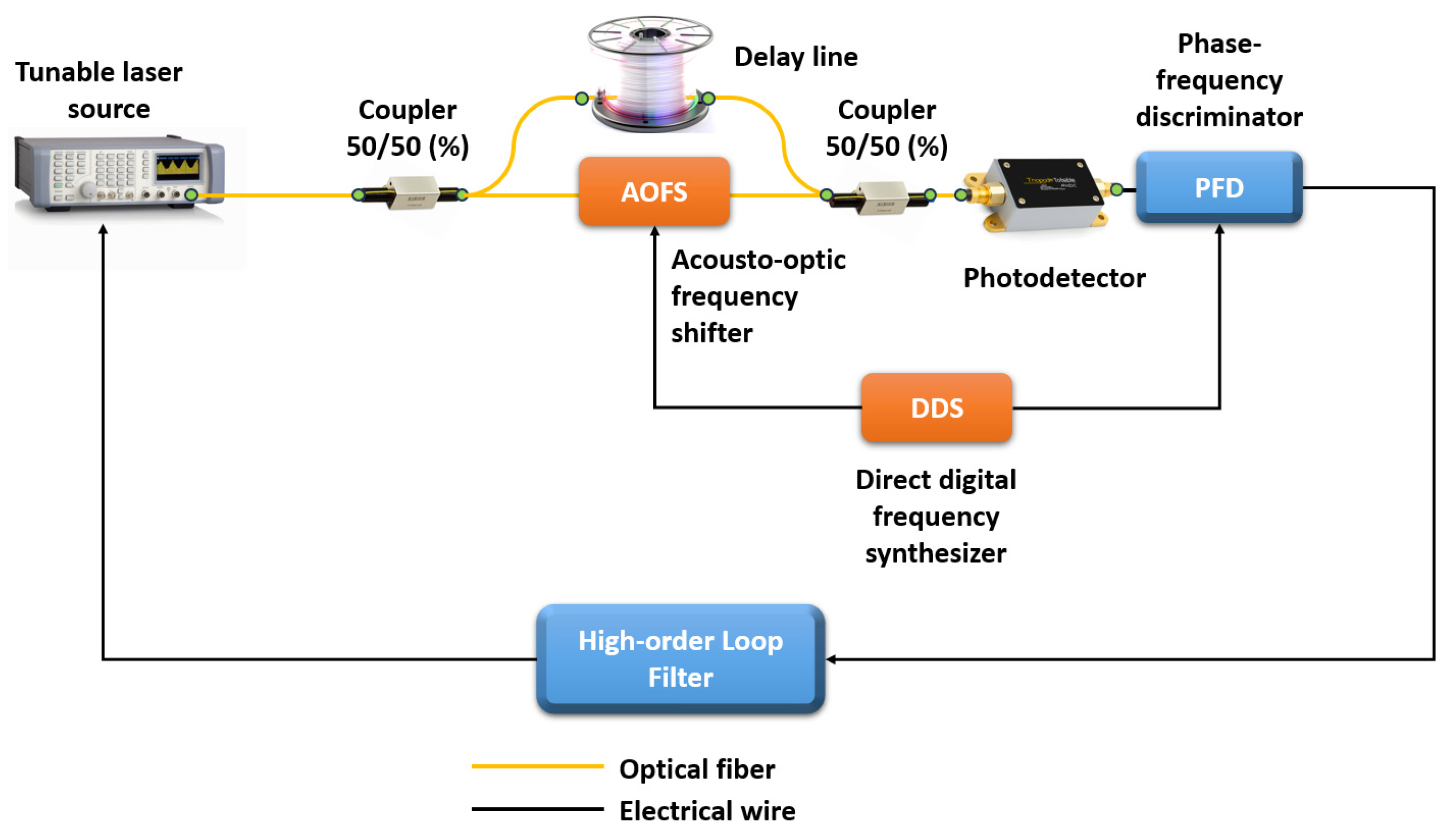


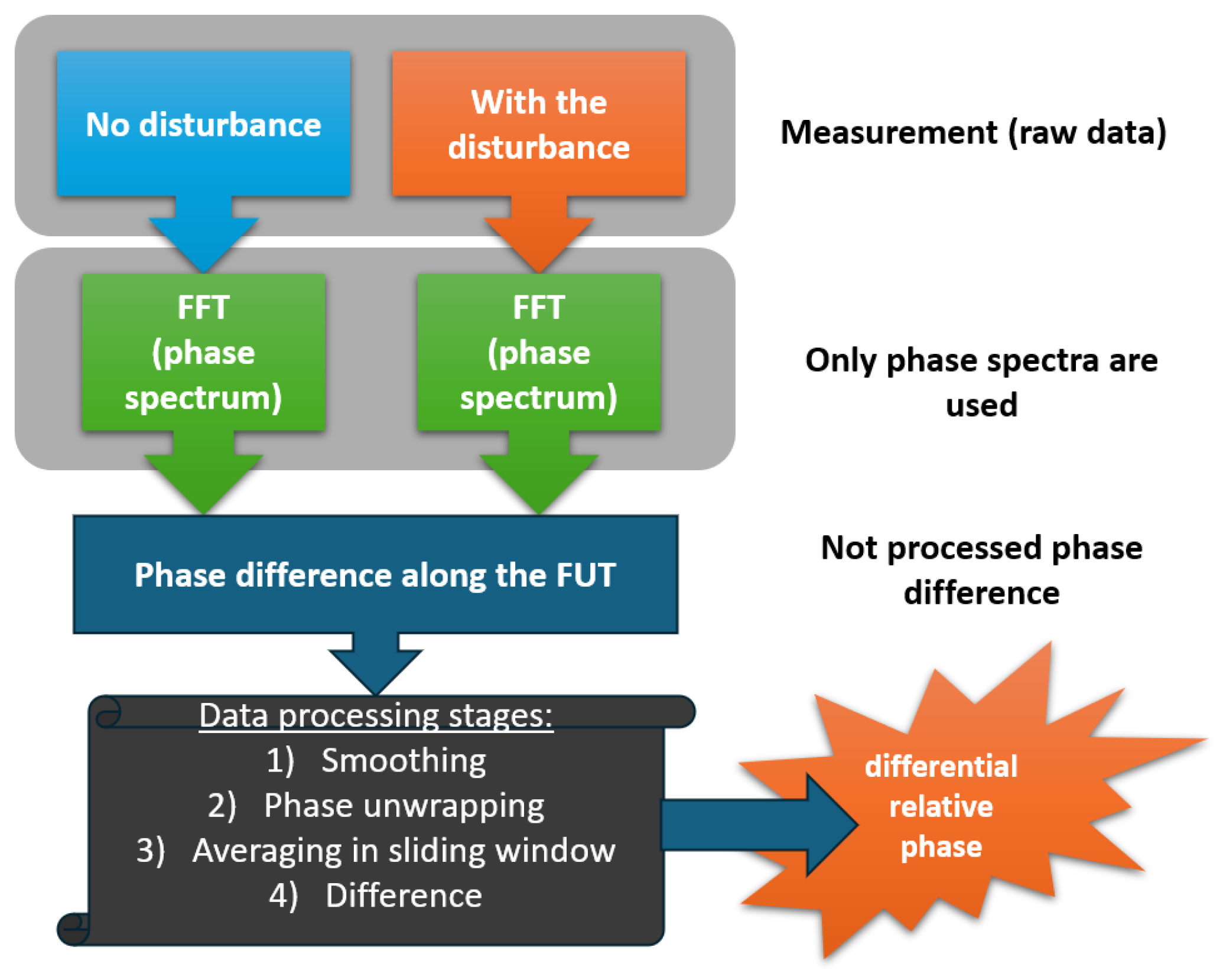
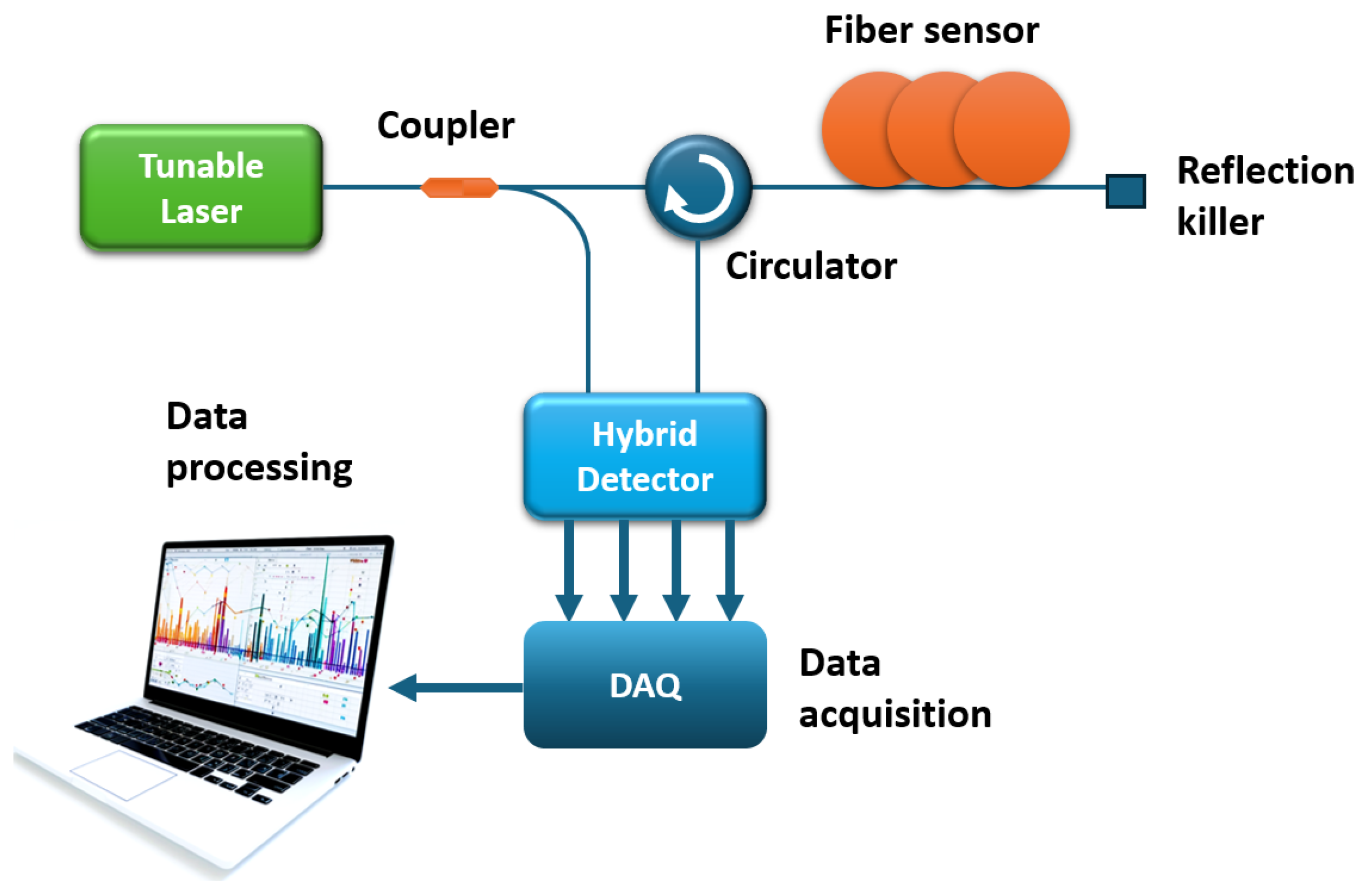

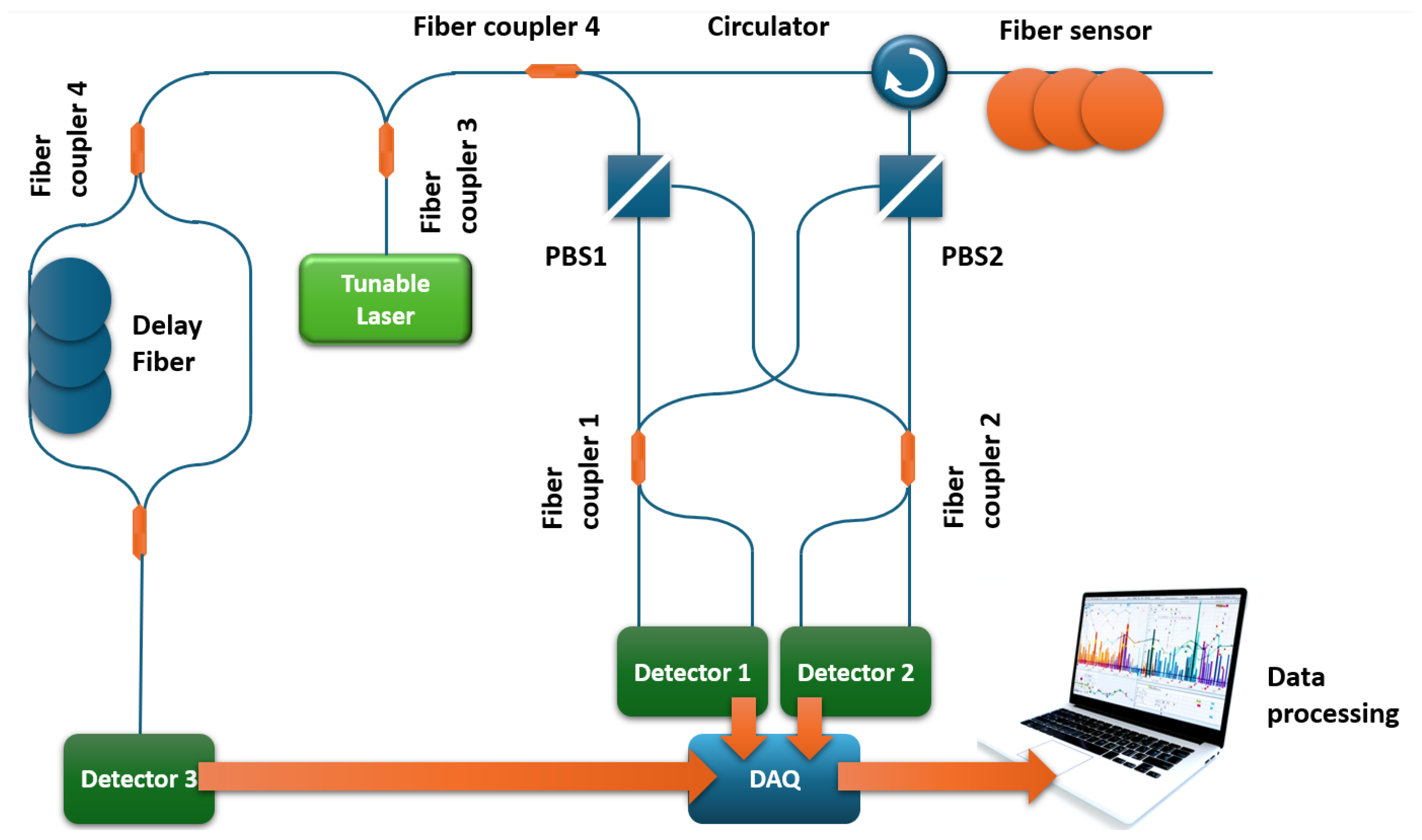

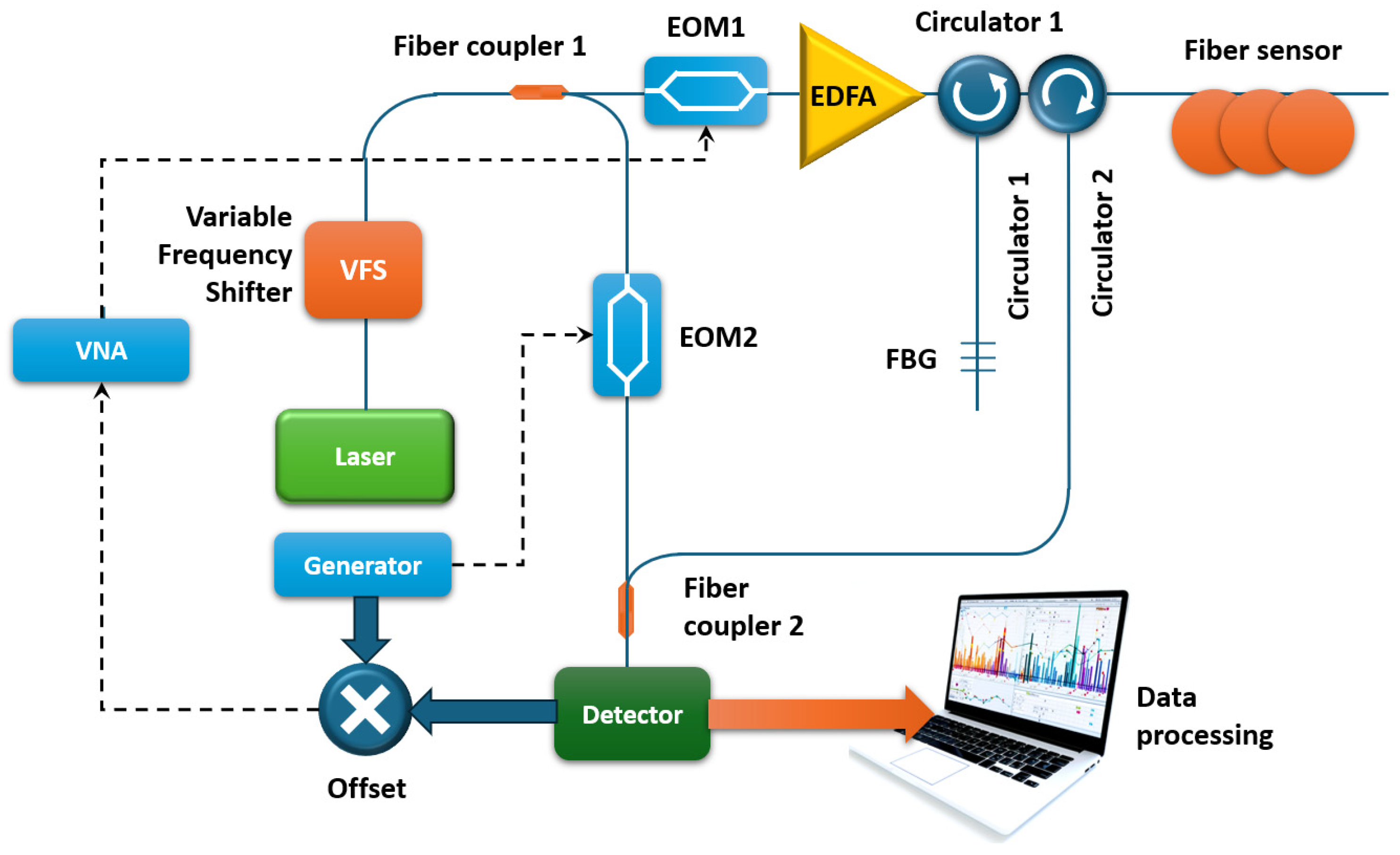
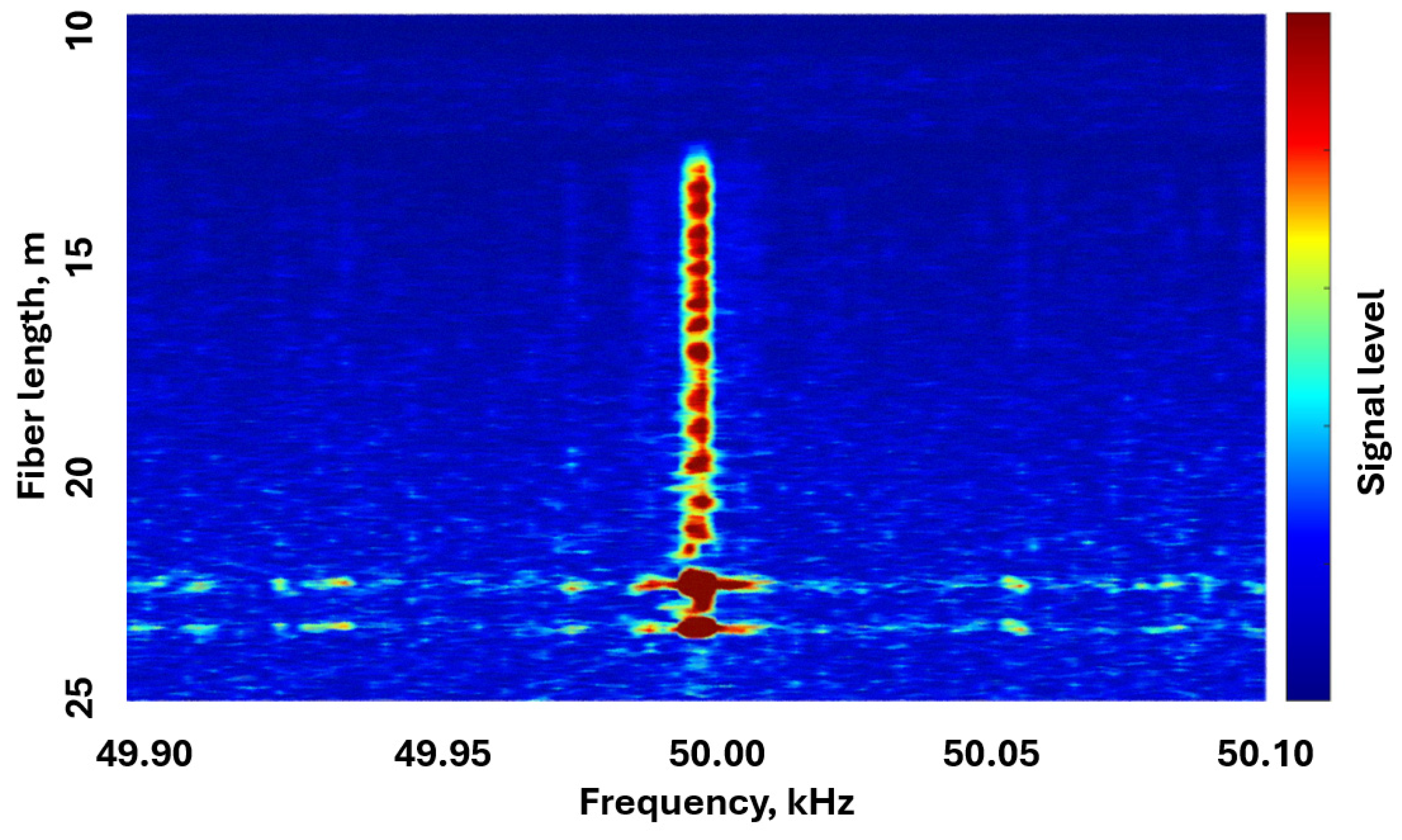

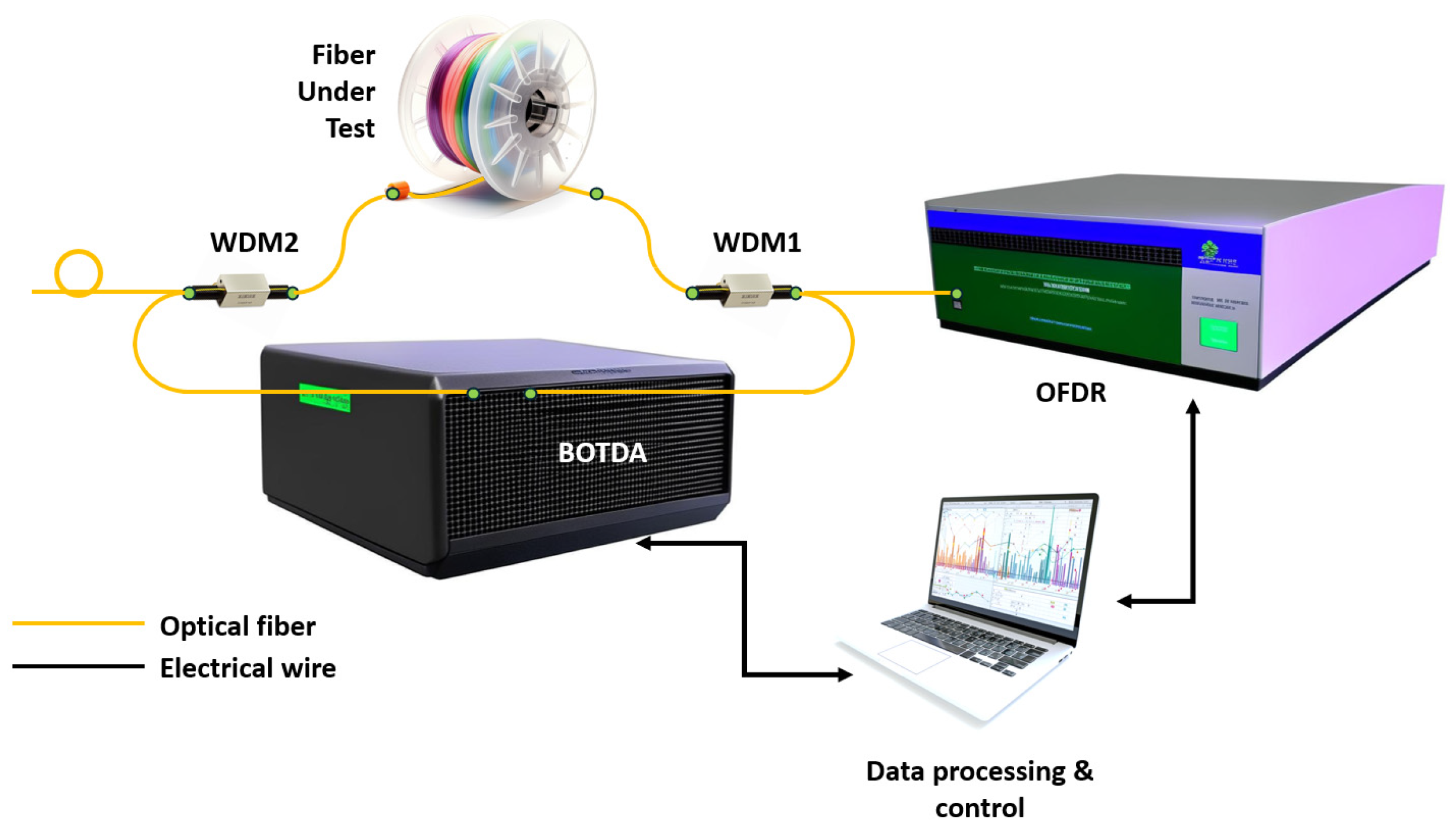
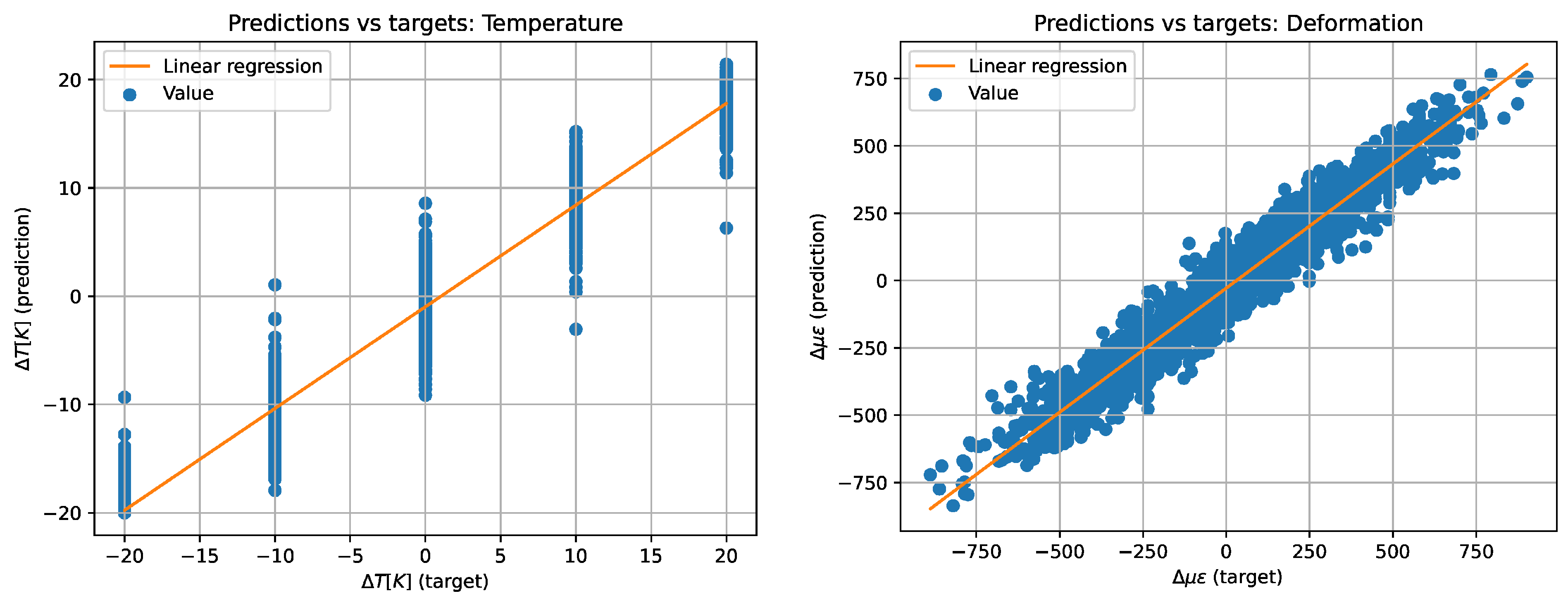



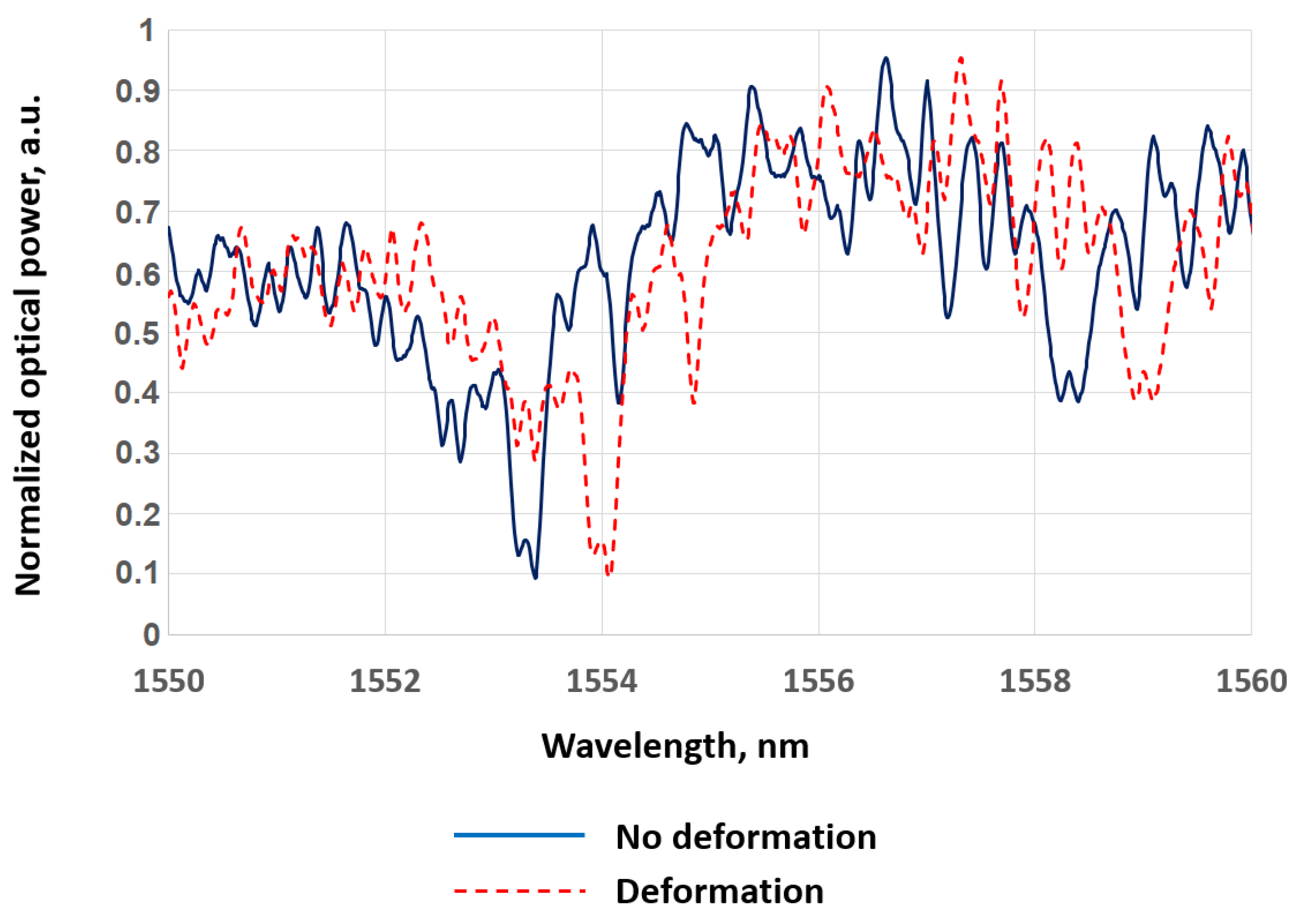


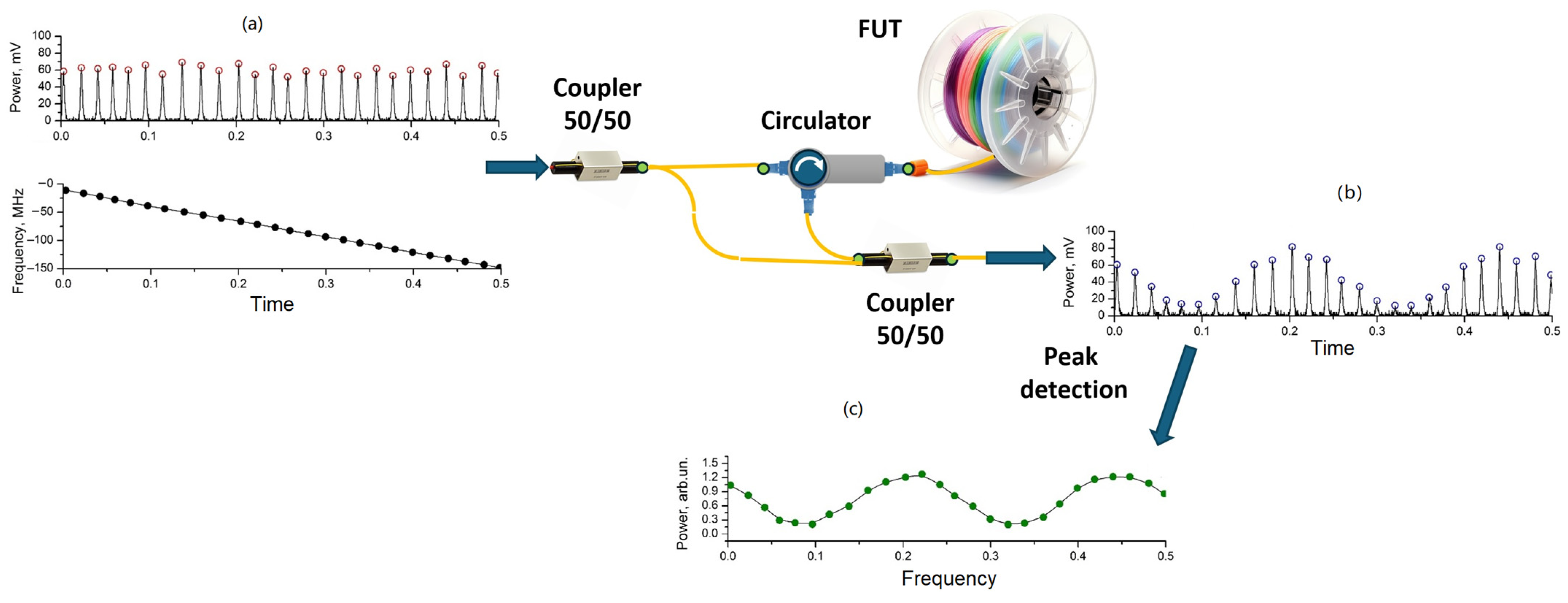
| Parameter | Units | Value | Comments | Ref. |
|---|---|---|---|---|
| Spatial sampling in back reflection measurements | μm | 21.3 | Obtained using the EFR method. Fiber length is 191 m with a 200 m optical path delay in the AUX. | [26] |
| Spatial sampling in sensing mode | mm | 0.857 | Obtained using a physics-driven neural network. | [66] |
| Lowest back reflection power registered | dB | −70 | A high-sensitivity, highly integrated, and low-noise coherent receiver module based on germanium-silicon photonic chips was used. | [32] |
| Temperature measurement range | °C | Up to 800 | Zirconia-doped fiber was used. | [49] |
| Strain measurement range | με | −10,000–10,000 | Spectral segmentation method was used. | [63] |
| Accuracy of temperature measurement | °C | 0.05 | VNA-assisted OFDR was used; spatial resolution is 3 m. | [78] |
| Accuracy of strain measurement | με | 0.25 | The differential relative phase method is used in the OFDR. | [60] |
| Accuracy of temperature measurement when distinguishing temperature and strain | °C | 0.1 | A 180 m FUT and a spatial resolution of 2.5 mm; PMF fiber. | [86] |
| Accuracy of strain measurement when distinguishing temperature and strain | με | 1 | ||
| Probing length in back reflection measurements | km | 242 | High-order optical phase-locked loop-assisted fiber laser with 4.3 cm spatial resolution; the backscatter measurement precision is 0.5 dB. | [35] |
| Probing length in temperature and strain measurements | km | 5.63 | A frequency-scanned φ-OTDR and phase cross-correlation were used. | [98] |
| Probing length in vibration measurements | km | 64 | Obtained using sinusoidal frequency sweep; detection of 400 Hz signal with a spatial resolution of less than 10 m. | [81] |
| Range of recorded vibration frequencies | kHz | Up to 50 | Obtained by adding reference vibration sources to the FUT; 25 m FUT length. | [82] |
| Best set of parameters for a single system | Spatial resolution of 0.857 mm, impact detection accuracy of 0.91 με, and sensor length of 140 m. | Obtained using physics-driven neural network. | [66] | |
Disclaimer/Publisher’s Note: The statements, opinions and data contained in all publications are solely those of the individual author(s) and contributor(s) and not of MDPI and/or the editor(s). MDPI and/or the editor(s) disclaim responsibility for any injury to people or property resulting from any ideas, methods, instructions or products referred to in the content. |
© 2024 by the authors. Licensee MDPI, Basel, Switzerland. This article is an open access article distributed under the terms and conditions of the Creative Commons Attribution (CC BY) license (https://creativecommons.org/licenses/by/4.0/).
Share and Cite
Lobach, I.A.; Fotiadi, A.A.; Yatseev, V.A.; Konstantinov, Y.A.; Barkov, F.L.; Claude, D.; Kambur, D.A.; Belokrylov, M.E.; Turov, A.T.; Korobko, D.A. Newest Methods and Approaches to Enhance the Performance of Optical Frequency-Domain Reflectometers. Sensors 2024, 24, 5432. https://doi.org/10.3390/s24165432
Lobach IA, Fotiadi AA, Yatseev VA, Konstantinov YA, Barkov FL, Claude D, Kambur DA, Belokrylov ME, Turov AT, Korobko DA. Newest Methods and Approaches to Enhance the Performance of Optical Frequency-Domain Reflectometers. Sensors. 2024; 24(16):5432. https://doi.org/10.3390/s24165432
Chicago/Turabian StyleLobach, Ivan A., Andrei A. Fotiadi, Vasily A. Yatseev, Yuri A. Konstantinov, Fedor L. Barkov, D. Claude, Dmitry A. Kambur, Maxim E. Belokrylov, Artem T. Turov, and Dmitry A. Korobko. 2024. "Newest Methods and Approaches to Enhance the Performance of Optical Frequency-Domain Reflectometers" Sensors 24, no. 16: 5432. https://doi.org/10.3390/s24165432





